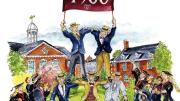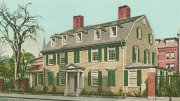1930
The Peabody Museum has sponsored two summer expeditions: the first will make a thorough archaeological survey of a large portion of Utah; the second will continue archaeological explorations in Czechoslovakia and the Balkans.
1930
Dunster and Lowell, the first two Houses to be built with funds provided by Edward Harkness, are under construction, as are new biology and physics labs, a faculty club, and Dillon Field House.
1935
Two Alumni Association representatives travel to the Wedgwood Potteries in England to oversee the final stage in the production of commemorative Harvard Tercentenary chinaware.
1935
Massachusetts governor James Michael Curley, addressing the Alumni Association on Commencement Day afternoon, stresses the obligation of universities to solve pressing economic problems; their failure to answer the question of work and wages, he declares, “constitute[s] an indictment of our educational system.”
1945
World War II ends on August 14 with more than 2,800 undergraduates on leave of absence for war service and only 400 attending a special summer session in Cambridge.
1950
The “nation’s oldest summer school” proudly reports a first: students in attendance from all 48 states and the District of Columbia, as well as representatives of 46 foreign countries, from Austria to Venezuela.
1960
Three cooperative houses, “the first units of contemporary design to be built at Radcliffe,” are under construction, thanks in large part to a gift from Susan Morse Hilles.
1970
The University switches to a Centrex telephone system, installed during a two-year period at a cost of $10.5 million, that allows incoming and outgoing calls to be dialed direct.
* * *
Five hardy and hearty members of the College class of 1900—the “Naughty-naughts”—celebrate the first seventieth reunion.









